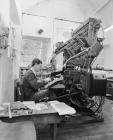Content can be downloaded for non-commercial purposes, such as for personal use or in educational resources.
For commercial purposes please contact the copyright holder directly.
Read more about the The Creative Archive Licence.
Description
Gee Printing works entrance with the proprietor's bay window.
At the time of its closure in 2001 the original Gwasg Gee printing works in Denbigh was an astonishing survivor of a traditional printing shop. It was the oldest surviving example in Wales and had a strong tradition of Welsh-language printing and publishing.
The press was founded in 1808 and acquired in 1813 by Thomas Gee, whose son of the same name (1815-98) took over its management in the 1830s and developed an ambitious programme of publication.
The premises in Chapel Street were occupied continuously by the press from the 1830s and are substantially unchanged since the mid-nineteenth-century. Increasing mechanisation led to expansion in the 1850s. The press buildings grew to enclose a courtyard, with an entrance large enough for carts, overlooked by Thomas Gee's first-floor office window.
The Gee family remained closely associated with the press in the twentieth century but shortly before World War II it was taken over by Morris T. Williams and his wife, Kate Roberts, a major literary figure whose novels and short stories portray the life of Wales quarrymen and their families.
The press assumed its final form in the post-war years. Williams died in 1946 but Roberts continued to run the press and publish its Welsh-language national newspaper,Baner ac Amserau Cymru(orY Faner), for another ten years.
To the rear of the premises is a small furnace where the lead type was cast. The machinery is mainly twentieth century in date, much of it German. It includes a Polar-Mohl guillotine, a Brehmer Leipzig book-sewing machine, a Stahl folding machine and the Heidelberg presses in the printing room. The compositing room, for setting the type, contains six linotype machines. These machines, latterly used for printing funeral and wedding services and the like, were the mainstay of a provincial printer. Gwasg Gee still retained an old-fashioned racks of poster type and compositing stones.
The printing works was photographed in 1998, before its closure. Technological changes have simplified the number of processes involved in printing but the enormous investments require economies of scale and large buildings on industrial estates are more suitable premises than constrained historic buildings in a town-centre. However, Gwasg Gee remains an important component of the built heritage of Denbigh. A trust is investigating new uses for the building, which it is hoped will incorporate a museum of printing.






Do you have information to add to this item? Please leave a comment
Comments (0)
You must be logged in to leave a comment